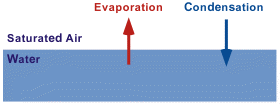|
Relative Humidity
indicates how moist the air is
Relative humidity may be defined as the ratio of the water vapor
density (mass per unit volume) to the saturation water vapor density,
usually expressed in percent:
| Relative Humidity (RH) = |
(Actual Vapor Density)
--------------------
(Saturation Vapor Density) |
|
X 100% |
Relative humidity is also approximately the ratio of the actual to the
saturation vapor pressure.
| RH = |
(Actual Vapor Pressure)
--------------------------
(Saturation Vapor Pressure) |
|
X 100% |
Actual vapor pressure is a measurement of the amount of water vapor
in a volume of air and
increases as the amount of water vapor increases.
Air that attains its saturation vapor pressure has established an
equilibrium with a flat surface of water. That means, an equal number of
water molecules are evaporating
from the surface of the water into the air as are
condensing from the air back into the water.

Saturation vapor pressure is a unique function of temperature as given in
the table below. Each temperature in the table may be interpreted as a
dew point temperature, because as the ground cools,
dew will begin to form at the temperature corresponding to the vapor pressure
in this table.
| (C) | Temp | (F) | | | Sat Vapor Prs (mb) |
| |
(C) | Temp | (F) | | | Sat Vapor Prs (mb) |
|
-18
-15
-12
-09
-07
-04
-01
02
04
07
10
13
16 |
|
00
05
10
15
20
25
30
35
40
45
50
55
60 |
|
1.5
1.9
2.4
3.0
3.7
4.6
5.6
6.9
8.4
10.2
12.3
14.8
17.7 |
|
|
|
|
|
|
|
|
|
|
|
|
| |
18
21
24
27
29
32
35
38
41
43
46
49
52 |
|
65
70
75
80
85
90
95
100
105
110
115
120
125 |
|
21.0
25.0
29.6
35.0
41.0
48.1
56.2
65.6
76.2
87.8
101.4
116.8
134.2 |
Chart adapted from: Ahrens
For example, if the water vapor pressure in the air is 10.2
millibars (mb), dew will form
when the ground reaches 45 degrees Fahrenheit (F).
The relative humidity for air containing
10.2 mb of water vapor is simply 100% times 10.2 mb divided by the
saturation vapor pressure at the actual temperature. For example, at 70 F
the saturation vapor pressure is 25 mb, so the relative humidity would be
RH = 100% X (10.21 / 25.0) = 41%

states of water
|
|

rising air
|
|


